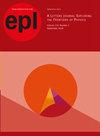Total free-free Gaunt factors prediction using machine learning models
IF 1.8
4区 物理与天体物理
Q2 PHYSICS, MULTIDISCIPLINARY
引用次数: 0
Abstract
Gaunt factors are fundamental in describing the interaction of free electrons with photons, playing a crucial role in astrophysical processes such as radiation transport and emission spectra. Traditional methods for computing Gaunt factors involve complex integrations and intricate mathematical formulations, often being computationally expensive and time-consuming. This study explores an alternative approach using machine learning models to predict free-free Gaunt factors. Three models were employed: Artificial Neural Network (ANN), Support Vector Regression (SVR), and Gradient Boosting Regression (GBR). The obtained results demonstrate high performance, with R2 scores ranging from 0.98 to 0.99, indicating the potential of machine learning models to accurately predict Gaunt factors.利用机器学习模型预测总自由度高特系数
高特因子是描述自由电子与光子相互作用的基本要素,在辐射传输和发射光谱等天体物理过程中发挥着至关重要的作用。计算高恩特因子的传统方法涉及复杂的积分和错综复杂的数学公式,通常计算成本高且耗时。本研究探索了一种使用机器学习模型预测自由高特因子的替代方法。研究采用了三种模型:人工神经网络 (ANN)、支持向量回归 (SVR) 和梯度提升回归 (GBR)。所得结果表明,机器学习模型具有很高的性能,其 R2 值在 0.98 到 0.99 之间,这表明机器学习模型具有准确预测高特因子的潜力。
本文章由计算机程序翻译,如有差异,请以英文原文为准。
求助全文
约1分钟内获得全文
求助全文
来源期刊

EPL
物理-物理:综合
CiteScore
3.30
自引率
5.60%
发文量
332
审稿时长
1.9 months
期刊介绍:
General physics – physics of elementary particles and fields – nuclear physics – atomic, molecular and optical physics – classical areas of phenomenology – physics of gases, plasmas and electrical discharges – condensed matter – cross-disciplinary physics and related areas of science and technology.
Letters submitted to EPL should contain new results, ideas, concepts, experimental methods, theoretical treatments, including those with application potential and be of broad interest and importance to one or several sections of the physics community. The presentation should satisfy the specialist, yet remain understandable to the researchers in other fields through a suitable, clearly written introduction and conclusion (if appropriate).
EPL also publishes Comments on Letters previously published in the Journal.
 求助内容:
求助内容: 应助结果提醒方式:
应助结果提醒方式:


